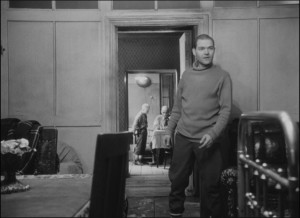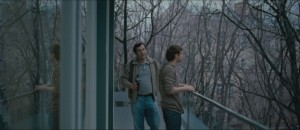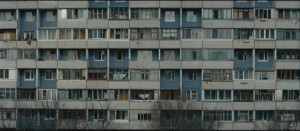Irina Aristarkhova, University of Michigan
One of foreign language films nominated for the 2015 Oscars was a Russian film, Leviathan (2014), directed by Andrey Zvyagintsev. Though the film received some government funding, Russian authorities at first refused its screening because they believed the film portrays the country in a negative light. After all, Russians do not drink as much nor are as corrupt as those portrayed in the film, the minister of culture said. People are better, with healthier habits. Services are better. And there are those stunning natural and post-industrial landscapes. The film can be seen around the world, including in Michigan, and, finally, in Russia (at first online and later in theatres that decided to show it). In Russia, the film took a life on its own but not because of the director’s wish to ensure that his own faith and hope in humanity shine (indeed, he seems to have had that intention). That has failed. Rather, the film is too close to home.
The film’s story is based on the eternal premise of “an individual squashed by the System.” Andrey Zvyagintsev, the director, said an American story of Marvin Heemeyer partially inspired the film. After a dispute over taxes with a city council and owners of a concrete manufacturing factory, Heemeyer, the owner of a muffler shop in Granby, Colorado, rampaged through the city on a reinforced bulldozer, in 2004. He became angrier and angrier with the mayor, the town council and the factory owners and took revenge on them. The event was televised live, and the vehicle became known as the “Killdozer”. Heemeyer eventually killed himself but not before he destroyed thirteen buildings in two hours.
Somehow, Heemeyer’s gesture of defiance, even by destruction and death, was too foreign for a Russian film. Zvyagintsev’s characters have no sense of personal power to oppose the system. An individual can only contribute to or partake of corruption, to get along or, at least, get out of the system’s way. There is no revenge, nor payback in Leviathan, only people doing things to other people. And even the death of one of the major figures in the film seems anticlimactic, as it happened for no reason whatsoever, and had nothing to do with opposing the system. Actually, many events do not make sense and the story jells poorly. But somehow it all works together in a magical identification. Even bad parts look good. Hence, the ease with which the film is recognized as hyper-realistic, familiar or even threatening to Russian national identity, is telling: several film critics confessed to personal memories matching those in the film events or settings and uncontrollable tears for “all of us.” Less the story makes logical sense, more realistic it looks: such is an effect of director’s restraint with phantasy and his melodramatic style.
In one of the most talked about scenes in the film, a mayor, who moments ago won a lawsuit against the protagonist to seize his house and land through a questionable court order, gets drunk in his limousine. He orders the driver to stop in the neighborhood to express his satisfaction and demonstrate his power to the homeowner, who has just lost his final lawsuit against the township. “All of this is mine,” the mayor gestures to the house and the surrounding land, “this, this, and this also.” “Take it,” answers the man, “will it fit into your limousine? Anything else?” The mayor, barely standing straight in his drunken stupor, answers: “All of you are insects. You don’t want to get along, and as a result you get drowned in shit.” As he argues with the man’s lawyer (who happens to be a sleek and successful army friend from Moscow), whether or not he has a legal right for entry on premises, the mayor screams: “Remember, you have never had any fucking rights, do not have them and will never have any!”
The film thus elegantly demonstrates that nothing can be done by an individual facing the corrupt and intertwined system consisting of business interests, politics, law and organized religion. Townsfolk, who are more or less part of the system, look jaded (a word that was also used by one of my Michigander students to describe how his generation feels vis-à-vis poverty in the U.S.). Of course, the town residents do not see themselves as victims of the system, because they are not. It is the system they have built and know well. They know that being “insects” not only does not prevent them from living their lives, but even adds intensity to their enjoyment of “simple pleasures” as the film portrays them: shooting bottles, gleaning extra warmth from a shared meal, drink and sex. Insecurity and instability are not feared. It is what brings community together. This kind of collective condition, where “bad is good, because we know that the bad brings us together and hence the good will pull us apart,” makes the film Leviathan so painfully familiar. Many critics noted their surprise that the film has become as controversial as it has, since Russians do not learn much new by watching it. There have been plenty of recent comedies and dramatic movies that portray the same Russia we see in Leviathan. After all, being human is about being weak too, right? Our life is hard. It is not a walk in the park.
***
An academic proposed gentrification as a sociological term to describe processes within one urban community she studied. It is not a “grassroots” term (for a better word). From that particular study in the U.K., gentrification has come to mean displacement of lower income residents by more affluent outsiders. Hence, as its usages spread outside of academia mostly by a university-educated public, it has taken on negative connotations. As useful as the term has been to describe and criticize similar-looking processes in other communities, the time has come to consider how far “gentrification” as a notion can take us with this built-in opposition of “us” versus “them.” It presumes that change is forced from the outside and there is little that “original” residents can do to stop it (especially in the context of manufacturing collapse and outside business interests). When used as an umbrella term that goes hand-in-hand with the notion of “urban renewal,” gentrification’s presence in that negative sense assumes this immediate connection: between positive changes in the community and its displacement by outsiders. Furthermore, as the presence of artists, designers, and other creative makers is often associated with such renewal, they also become associated with the negative connotation of gentrification and are divided into “local” and “outsiders. ” I would caution against this divisive underpinning of gentrification as the opposition between “insiders” and “outsiders,” or between “victims” of gentrification and “beneficiaries” of it. Problematically, worrying about “gentrification” in general oppositional terms risks to paternalize the very communities the critics of disempowerment seek to help.
Does it mean I do not believe in usefulness of the notion of gentrification? Of course, not. I only caution against its universal application and quick separation of “us” from “them.” Gentrification can also be used to discuss important topics of quality of life, public space, social contract, and elements of urban renewal beyond the “us” versus “them” opposition. Let us contemplate for a minute gentrification as a process that happens within an urban community and imagine what happens if the root “gentle” in gentrification is resurrected from within. What is “gentle” in gentrification? Initially, the gentle was about “gentile” – the class separation of British aristocracy (where the gentleman comes from too). Certainly, we would agree that “gentile” classes and gentle are not the same. I am using the notion of gentleness here to rethink gentrification and imagine it in less negative and divisive terms, albeit without certainty of success vis-à-vis a corrupt power and its violent history (see above, on Leviathan section). As a reworked definition, I take gentrification to mean any marker in one’s environment that represents a quality of life of one’s community (neighborhood, school district, playground area, etc.). Such markers usually relate to the notion of the public: public lights, public transport, public safety, public sanitation, public parks, public water, public museums, public schools, public art, etc. I am aware that my working definition here differs from more established academic definitions of gentrification that define it as “working class” areas becoming “middle-class” and, hence, leading to a displacement of lower income inhabitants. This article mines gentrification for potential other usages .
When the gentrification discussion is reduced to the question of “us” (insiders) versus “them” (outsiders), the conversation often circles around the need for vigilance in relation to who is “us” and who is “them.” Because “they” (outsiders) can overtake “us” (insiders), those from within who seek the markers of gentrification can at any time become labeled as collaborationists with “outsiders.” The creative class, already under suspicion but also the one that is most visible as a “marker” of urban renewal, is often in the middle of such divisions as “us” versus “them.” Such identification is very difficult for an artist– to persuade his or her community that they are not outsiders, of any community. As makers, they are supposedly part of the working class. Often with design or art college degrees, they could be seen on par with engineers: finding solutions to complex problems. But neither the working nor engineering classes accept artists, though artists become essential to any process of the betterment of a public environment. The label of gentrification gets thrown around in situations that touch upon almost any creative transformation of a public environment. Even if good plumbing can been seen with less suspicion, visual quality of one’s surroundings is seen as some kind of “extra,” thus problematically leaving intact an impoverished, built environment driven by corporate decisions and private interests without much regard for the sensory and embodied experience of the public.
Things get complicated when we criticize gentrification as urban renewal with its improvement of public spaces and reduction of necessity to come together to fight everyday problems of walking, driving, or taking public transport for others while at the same time enjoy or advocate similar spaces and services within our own communities. Moreover, the creative class and their presence in a community are seen as alien, as outsiders, un-belonging to “our” community. Currently, in Russia, there is a strong association between creative professions and immorality, feminism, homosexuality, lack of religious piety and traditional family values, as well as a disregard for order and authority. “Those people are not part of us” is a phrase that starts problems rather than gets them resolved.
Artists and writers are easy targets. Hence, it is important to consider that being an artist is already not some “gentrified” choice in a community (in that negative original sense). There is no “us” and “them” as most residents operate across multiple identities, families and communities. In situations where they have to choose between “us” and “them,” having a strong international and outside support is both bad and good for an artist. It is a good pitch to funders but also renders an artist and his or her projects vulnerable to charges of gentrification and outsider status. Thus, many tried to suggest in Russia that Leviathan is unpatriotic because it is based on a foreign, American, story. A decision to become part of a creative profession is a very difficult decision, especially when there is almost no public funding (as it is increasingly the case). It is especially sad that one’s own community, one’s own neighborhood, could be against you, since you are rocking the boat and your choice is very different from almost everyone else’s choices. The negative academic nature of gentrification studies needs to account for a more nuanced and flexible notion of a neighborhood, where business and other interests, as well as public art, are not only labeled as “outside” phenomena.
Leviathan is often described as a film without heroes, despite the director’s intentions. A person ends up rejecting the system because he stubbornly wants to keep his house rather than sell it to the city: he is not an exemplary father, husband, citizen. He is not interested in changing the system. He just wants to continue living in his house. Nothing more. And when he fails, he is almost ready to move on, whatever it might mean (he was an alcoholic prior to these events anyway). The film shows how people become heroes because everyday life requires heroism, which is a problem. Every productive effort or little act of kindness, every gentle action, which would be considered “normal” elsewhere, implies something extraordinary. One puts oneself in danger or on notice by one’s community and family, by police, by friends. If you are not getting along with the most despicable cases of corruption or abuse of power, you are “taught a lesson.”
“Don’t be a hero” is a common saying in situations where citizens are reminded and remind themselves and others around them that they are “insects” that have “no rights.” This is reality and one needs to be a realist, one hears often. Therein enters art with its complicated relationship to pragmatism. Whether it is Leviathan or many other cultural products, they become a part of reality. But they are far from pragmatism. They represent gentle choices by those who become heroes because there is no gentrification in sight and where art, imagination, dreams are seen as outsiders. “What gentrification?” I ask. Bring it on.
March 2015
This piece originally appeared in an online journal, ∞ mile (infinite mile): a journal of art+culture in Detroit, and has been republished with the author’s permission. Please visit the original site at: http://infinitemiledetroit.com/What_Gentrification.html
Gentrification
Cassio de Oliveira, Vanderbilt University
As a socio-economic phenomenon, gentrification (in Russian, джентрификация) finds staunch advocates as well as vocal critics. The most typical examples of gentrification—from inner-city London to New York’s neighborhoods of Harlem and Williamsburg, to (all of) San Francisco—consist of the renovation and remodeling of properties in low-income, formerly undesirable or neglected urban neighborhoods. The expectation of attracting high-middle-class families and individuals causes real estate speculation and rent or property-price inflation, with the attendant displacement of low-income dwellers. Defenders of gentrification argue that it results from the classical and fair interaction of market forces of supply and demand. Its critics argue that it constitutes one of the most jarring examples of the damage that predatory capitalism inflicts on the urban social fabric once government and civil society hand over the reins to individual actors (such as real estate developers and speculators, hipsters, and foreign magnates wishing to stash their money in a safe investment). These disagreements notwithstanding, both camps agree that gentrification is, at its core, an inherently capitalist occurrence, the purest manifestation of the invisible hand of the market, freed from zoning regulations, citizen protests, and postwar Brutalist architecture.
Thus there can be little talk of gentrification, as a product of market forces, in the Soviet period. However, since the fall of the Soviet Union, and especially following the momentous economic growth of the aughts as a result of the oil boom, there has been a distinct movement in Russia’s large cities toward the renovation and occasional reconstruction of neighborhoods. This can be seen, more frequently, in attempts to demolish perceived Soviet-era eyesores and replace them with new constructions, as the examples of the hotels “Rossiia” and “Moskva” demonstrate (the former was demolished, the latter not, following protests of architectural historians and other cultural groups); or it can manifest itself in the form of classical, Western-style, gentrification (as in the vicinity of the Serp i molot neighborhood in Moscow: http://www.the-village.ru/village/city/infrastructure/139299-serp-i-molot).

In the Soviet Union, a country faced with a permanent housing shortage throughout its existence, the average citizen’s dream was to have a private space of her own, regardless of where in the city it might be located (but see also inhabitants of communal apartments who prefer their central location to the privacy of the newer constructions in the outskirts of cities: http://kommunalka.colgate.edu/cfm/v_tours.cfm?ClipID=531&TourID=95). The Soviet ideal, expressed in a film such as Ironiia sud’by, ili S legkim parom! (The Irony of Fate, 1975, dir. El’dar Riazanov), was a form of anti-gentrification: a country of uniformly equal apartments, the doors to which can all be opened with the same key, located on streets with identical names, where the only differential is the geographical location of the city (in the film, Moscow and Leningrad) rather than the apartment itself.
Yet gentrification, at least as an aspirational goal, also manifested itself in Soviet times as the desire for one’s neighbors in a communal apartment to move out rather than as the desire to move elsewhere closer to the center. This is reflected, for instance, in Abram Room’s Tret’ia Meshchanskaia (or Liubov’ vtroem; Bed and Sofa, 1927), in which Volodia arrives in Moscow from the countryside and begins to live with his wartime friend Kolia and his wife Liuda. An affair between Liuda and Volodia ensues, and Kolia, a construction engineer, decides to leave the house, recognizing his ironic situation as he exclaims “I am a builder myself, and yet have nowhere to live” («Сам строю, а жить негде»). At its core, Bed and Sofa is not (just) a love triangle, but a tale of a different sort of exchanges, involving housing arrangements as well as social status. (Significantly, this tale takes place during the market-friendly NEP era.) At the end of the film, the men keep the well-located Moscow apartment, while Liuda, pregnant with a baby whose father is either of her two lovers, decides not to abort the child. Instead, she hops on a train, presumably to build socialism and raise her child in the country’s new frontiers.
In contrast with Room’s mock-kommunalka, Aleksei German’s Moi drug Ivan Lapshin (My Friend Ivan Lapshin, released 1984), set in the year 1936, depicts a collectivist utopia filtered by the grown-up’s glance back at his childhood among policemen who still earnestly believed in the rightfulness of their fight against banditry. German’s use of deep focus is particularly suitable to the portrayal of the multiple spaces – and inhabitants – of the policemen’s collective apartment.

The destruction of this utopia takes place in Khrustalev, mashinu! (Khrustalev, My Car!, 1998), German’s subsequent film. At the beginning of the film, the long takes emphasize the labyrinthine spaces of the elite mansion where Dr. Iurii Klenskii and his family live. As the film follows Klenskii’s downfall in the wake of the Doctors’ Plot in the late-Stalinist era, his wife and son experience—to a middle-class mentality—an even worse fate than Klenskii’s: they move to a communal apartment, losing the privacy and space afforded the Soviet elite. The move constitutes a nightmarish experience that contrasts sharply with the narrator’s gaze, at once wistful and ironic, on communal life in Lapshin.

Inhabiting a private space in the center of the capital, as Klenskii does on the eve of the Doctors’ Plot, might be the closest thing to gentrification that the Soviet middle class could enjoy. In post-Soviet cinema, however, gentrification is expressed as the yearning for a space which is not only private (with privacy having already become the crowning achievement of late-Soviet urban living), but also qualitatively better. It is such a yearning that Andrei Zviagintsev’s Elena (2011) addresses: the eponymous protagonist shuttles between her husband Vladimir’s smartly decorated, large flat in a posh Moscow neighborhood, and the cramped apartment in the outskirts of the city where her son Sergei lives with his wife and two children (with another one on the way). In an interview, Zviagintsev declared that “I would like to believe that ultimately in the film there is no distinction between ‘good and bad,’ ‘rich and poor’; there are instead representatives of different worlds, who are ‘caught’ at a given moment” («Мне хотелось бы верить, что на самом деле в фильме нет деления на “хороших-плохих, бедных-богатых”, а есть представительство от разных миров. Причем, они “схвачены” в определенный момент.», http://www.svoboda.mobi/a/24337571.html). It is such a moment that Elena, as the character who ties the different plotlines, makes possible; her literal and metaphorical travels expose the peculiar reality of gentrification in the post-Soviet era, in which the different worlds of center and periphery have been segregated altogether. Or so Vladimir, the husband, would wish: as he drives to the gym—located, significantly, in a repurposed industrial building—he passes by, and ignores, the crews of Central Asian laborers on their way to work.

Gentrification is portrayed in Elena as the product of market forces, insofar as Vladimir can afford the lifestyle of Moscow’s posh neighborhoods. The forces of personal privilege and connections rebel against this form of gentrification, as Sergei and his family move into Vladimir’s apartment after Elena murders him. As they used to do in their suburban apartment, Sergei and his adolescent son are shown leaning on the parapet in the balcony of the new apartment and spitting from there on the street.
Elena’s family leaves behind the nondescript grocery store and street fights under the shadow of the gigantic power station, yet it is unclear if it brings along the wherewithal required to incorporate the external values of the middle-high class. Despite Zviagintsev’s ostensibly nonjudgmental stance, Elena speaks to a specific set of middle-class values, foremost of all propriety. These values manifest themselves in the viewer’s simultaneous reproach and pragmatic understanding of Elena’s decision to kill Vladimir, as well as in the horror at the arrival of the suburban newcomers to a neighborhood, the good taste and homogeneity of which should remain untainted. To a middlebrow viewership spellbound by Zviagintsev’s sober aesthetics, the move (socially) up and (geographically) to the center represents both a tragedy and an aspirational goal.

Leviafan (Leviathan, 2014), Zviagintsev’s subsequent film, replays the emphasis on housing, property, and propriety that figures in the imaginary of Elena, but transfers the narrative to the surreal setting of a fictitious coastal village in the Russian Far North, where Kolya’s strangely stylish house with a view of the bay is confiscated by a mayor seemingly intent on using the land to build his own house. Like Elena, Leviathan speaks to some of the Russian middle class’ greatest fears—in this case, government abuse, violation of property rights, and destruction of the family nucleus. High-profile cases of international repercussion, such as the break-up and subsequent bankruptcy of Mikhail Khodorkovsky’s Yukos Oil Company in 2003, or the arrest and murder in prison of accountant Sergei Magnitsky in 2009, exemplify the societal problems that Leviathan addresses, yet the film treats these issues as a systemic issue affecting all of Russia’s population, including its less-privileged middle-class citizens. As Andrei Movchan explains in reference to the all-encompassing ills of corruption, “You won’t open up a bakery if a bandit will come tomorrow and set fire to it. Or if a tax inspector will take all your money. Or the chairman of the town committee will turn up and eat up all your rolls” («Вы не откроете булочную, если завтра придет бандит и ее сожжет. Или налоговик – и все отберет. Или заявится председатель горсовета и съест все булочки.» https://slon.ru/posts/56922). Unlike Elena, however, Leviathan offers very little by way of material consolation. If anything, the closest to a (negative) catharsis offered by Leviathan consists of the demolition of Kolya’s house and foundation of a new church on the property—a not unusual occurrence at the state level in Russia, for instance in the case of Moscow’s Church of Christ the Savior, successively built on the former site of a monastery, demolished, then rebuilt decades later.

The ending of Leviathan may thus be a staunch reminder of the forces of destruction and reconstruction constantly at play in Russia’s real estate (as well as in society at large). Yet it is also symptomatic of the peculiar role played by non-monetary exchanges in Russia, something that may seem baffling to Russians and foreigners alike who wish to get their money’s worth when buying property: to these people, London and New York appear as better alternatives.
December 2015

